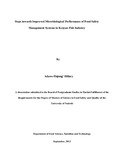| dc.description.abstract | Despite the existence of several Quality Assurance (QA) standards and implemented food safety management systems (FSMS), fish processing plants are still facing food safety performance challenges worldwide. This includes food borne outbreaks and the associated economic losses. This study aimed to assess performance of fish safety management systems and the microbial performance of core control and assurance activities implemented by the fish processors in Kenya and recommend appropriate measures for their improvement. Kenyan fish processing plants that have recently improved their FSMS after major export bans from the European Union were selected for case study. Nine fish processing companies were selected randomly for analysis and grouped into three classes that typically represent small, medium and large sized; based on varying utilized operational capacities, number of employees and certified FSMS. A FSMS diagnostic tool with checklist was used to assess the context characteristics, core control and assurance activities and food safety (FS) performance level of the production units for each company. A microbiological assessment tool was also used to systematically analyze microbial counts of selected safety, utility and hygiene indicator microorganisms at identified critical sampling locations in order to evaluate the actual microbiological performance of implemented FSMS
Majority (6/9) companies operated at moderate to high risk context but with an average performing FSMS. This situation could be insufficient to deal with ambiguity, uncertainty and vulnerability issues in the plants context characteristics. The contextual environment in which companies operated posed high demand on their FSMS in terms of risk posed by product characteristics (nature of raw materials) and chain environment characteristics. In terms of the latter, the risk posed by low power in supplier relationships was high coupled with low degree of
xii
authority in customer relationships. Lack of authority in relationship with suppliers would lead to high raw material risk situation. Even though cooling facilities (a key control activity), was at an advanced level, there was inadequate packaging intervention equipment which coupled with inadequate physical intervention equipment could lead to further weakened FSMS performance. However, most of the FSMS indicators revealed that the sector performed at average in its control and assurance activities. The microbiological assessment scheme revealed that Salmonella was absent in all critical sampling locations indicating effectiveness of the implemented FSMS against this organism. End product (fish) analysis showed that more than 67% of the studied companies had microbial counts within the legally accepted microbiological limits, hence good performance. The hands or gloves of food handlers from majority of companies (89%) were highly contaminated with S. aureus above the recommended limits. Performance of large sized companies was better than medium and small sized ones in majority (4/6) of the critical sampling locations. High variability in Enterobacteriacea was noticed in 56% of the companies while for TVCs it was 78% of the companies. This indicated a weak FSMS incapable of handling the microorganisms.
For the fish companies to improve their FSMS in terms of their microbiological performance to higher level and enhanced predictability, it is suggested that they base their FSMS on scientific information sources, historical results and own experimental trials in their preventive, intervention and monitoring systems. Specific suggestions are derived for improvements towards higher FSMS activity levels or lower risk levels in context characteristics and enhance their microbiological performance.
scheme, Fish industry, Context characteristics, Control Activities, Assurance Activities | en |

